The Anatomy of the Architectural Book: Magical Moves
In 1586 Domenico Fontana completed the extraordinary task, commissioned by Pope Sixtus V, of moving the Vatican obelisk. The structure was said to have a ‘mysterious magic of an unknown civilization’, accepted by Christians due to the belief that it had witnessed the martyrdom of Saint Peter. In this text, André Tavares tells the story of this incredible feat of engineering. His words are accompanied by detailed pictures taken from Fontana’s own book, Della transportation dell’obelisco Vatican et Delle fabric di nostro signore Papa Sisto V (1590).
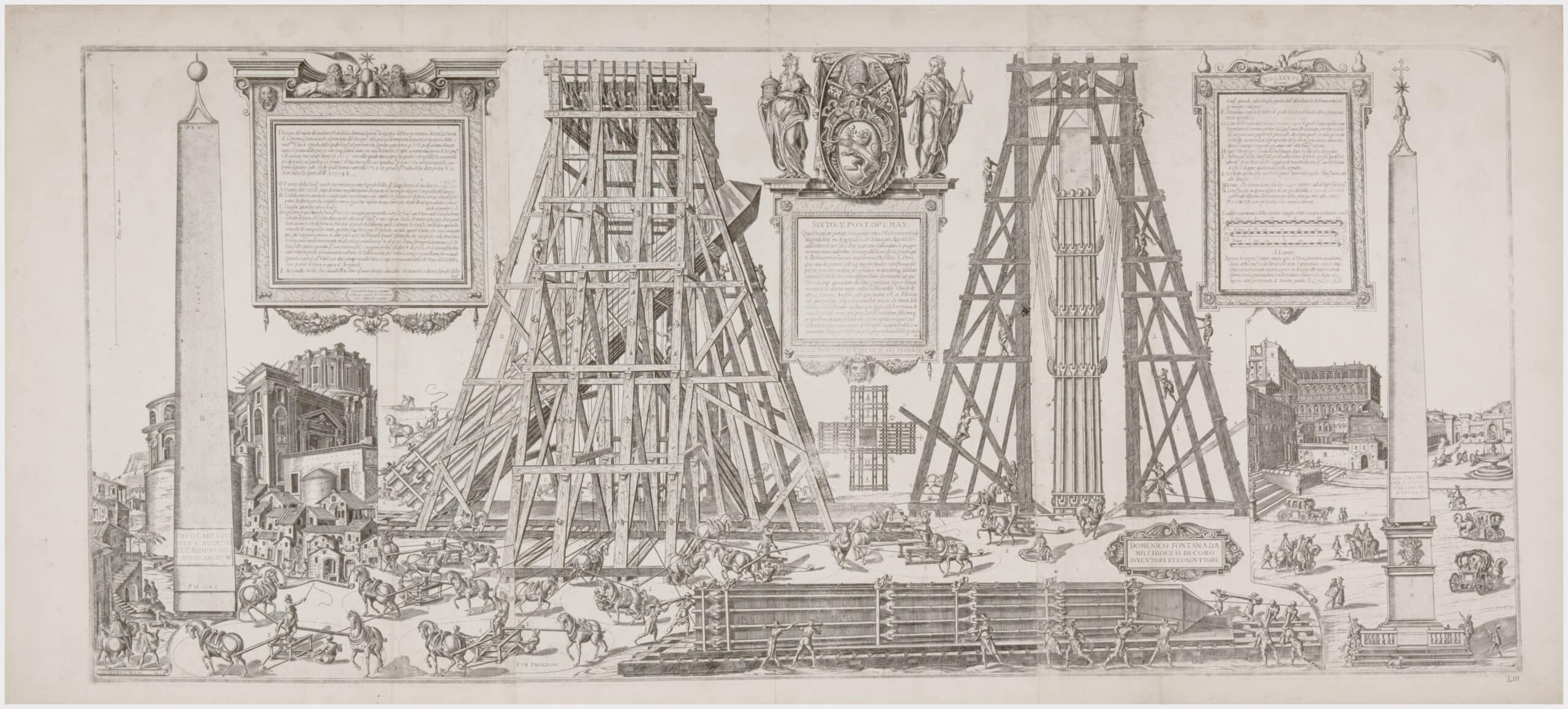
On Wednesday, 7 May 1586, the architect Domenico Fontana (1543–1607) was accompanied to his home by the sound of drums and trumpets. [1] He had just reassured Pope Sixtus V (1521–1590) of the successful completion of the delicate operation of lowering the Vatican obelisk, a 25.3 m high stone weighing hundreds of tons; it was the first step in the process of moving it to its new location in front of St. Peter’s Basilica. [2] The obelisk had been brought to Rome from Egypt in 37 or 38 CE for Caligula, who had it raised at the centre of a circus on the Vatican hill. By 1586, it was the only obelisk still standing of nearly fifty that had made the perilous trip across the Mediterranean to symbolically reinforce the magnificence of Imperial Rome. [3] Associated with the mysterious magic of an unknown civilization, the Vatican obelisk — or needle, as it was called — was believed to have witnessed the martyrdom of Saint Peter and thus acquired a powerful Christian symbolism. Bramante (1444–1514) proposed moving the obelisk in the early sixteenth century as part of his plan for the new Saint Peter’s, but this was not done during his lifetime: the problem was that the technical skills needed for such a venture had been lost. Without access to this expertise, the stakes were just too high. No Pope would risk the embarrassment of being responsible for damaging such a sacred object.
Eventually, for Sixtus V, appointed in 1585, this obelisk and its rich associations became a priority in his strategy to Christianize Roman antiquities. The Pope expected Christian pilgrims to come to Rome to venerate Christian sites and not, as was quite common, to delight in the grandeur of the ancient ruins. To highlight Rome’s Christian heritage, he planned major urban transformations. On his orders, statues of Saint Peter and Saint Paul were placed atop the columns of Trajan and Marcus Aurelius, and when the Vatican obelisk was finally set up in front of Saint Peter’s, he had its pagan and magical connotations exorcised with holy water and the bronze sphere at its tip — rumoured to hold the ashes of Julius Caesar — replaced by a gilt crucifix. Such powerful symbolic moves required equally powerful technical skills, thus the ‘drums and trumpets’ celebrating Fontana’s accomplishment are probably not an exaggeration, even though the project was not even half-finished on that Wednesday in May: the obelisk had been lowered, but it still had to be moved and raised. We are only on page seventeen of the exquisite book Fontana published to celebrate his work. [4]
Della trasportatione dell’obelisco vaticano et delle fabriche di nostro signore Papa Sisto V was printed in 1590, just before Fontana left Rome, and just after the Pope’s death. No expense was spared to ensure the success of the move of the obelisk, and the same can be said of the book, lavishly illustrated to immortalise the achievements of Sixtus V and his architect. As the title indicates, the transportation of the obelisk was but one of Fontana’s many works for the Pope; it takes up just thirty-six of the book’s hundred and eight pages. The remaining pages record a variety of works of architecture and engineering: repairing and moving other obelisks; the design for the Vatican Library; fountains, doorways, and palaces; and, perhaps most amazing of them all, the rotation of the old Manger chapel at Santa Maria Maggiore (which was achieved without dismantling the chapel — Fontana lifted and swung it by ninety degrees). However, despite the quality of the projects in the latter part of the book, the first third is what made Fontana’s reputation, both as a bookmaker and engineer, with its stunning depiction of the progress of the Vatican obelisk’s erection. The book itself was a near-magical technical achievement: the first section recreates the suspense experienced by those present at the exciting moments of raising, lowering, moving, and re-erecting the gigantic stone, controlled by a gigantic machine — part scaffolding and part crane — that Fontana called a castello. For those in attendance it was certainly a religious experience, corresponding to the ambitions of Sixtus V. After two early masses, the 907 workers kneeled and took communion just before the work began. Before an enormous crowd, the complex procedures that had been rehearsed beforehand took place in complete silence. Imposed at risk of severe penalties, this silence dramatically highlighted the precise moment when the needle was raised from its thousand-year-old base: ‘It seemed as if the earth shook, and the scaffold let out a great noise as all its timbers tightened under the weight.’ [5] The book aimed to convey this drama.
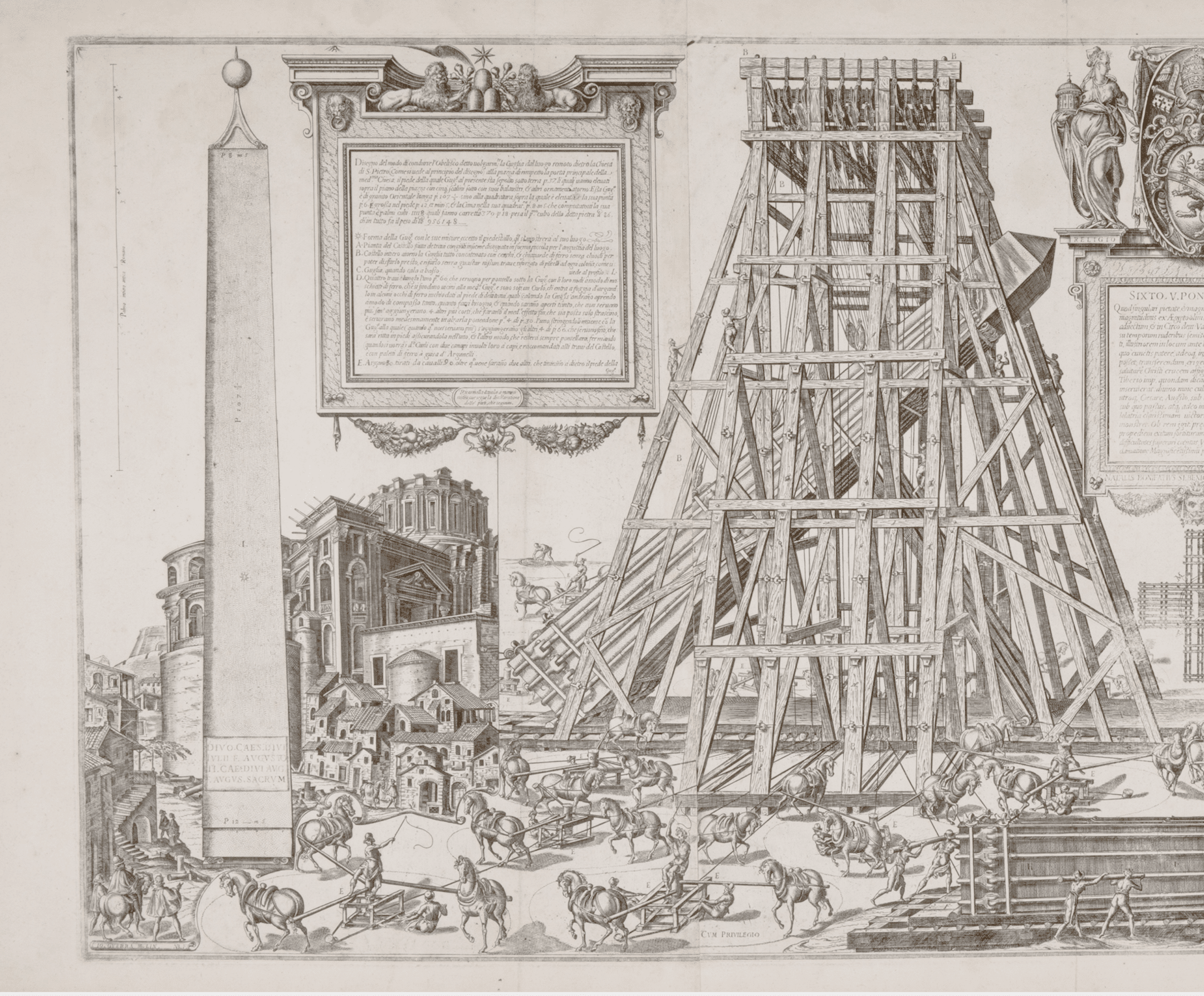
The obelisk was moved about 270 meters east, and the sequence of the pages allows the reader to follow that movement step by step. Fontana aimed to demonstrate ‘to the eyes of the readers, for their clearer comprehension, all the important actions used to this end.’ [6] Being an account as well as a celebration, the book benefited from the success of previously printed material. In March 1586, before the procedure took place, an image describing the planned process was published, designed by Giovanni Guerra (1540–1618) and engraved by Natale Bonifazio (1538–1592). [7], [8] The print, 119 cm long, presents the successive steps of the narrative, reading from left to right, just as the book would later do in a different format. At the left side of the framed image, the obelisk stands in its original position; then it is depicted being lowered inside the castello, shown in side elevation, onto a sledge. The sledge appears again at the bottom of the plate where we see the obelisk being transported before being re-erected in the castello, shown this time in a frontal elevation, and finally, at the extreme right, the stone is shown successfully standing in its final position. This image contrasts with another panoramic engraving — by the same authors and in the same format, but published in August, when the obelisk had already been laid in the sledge and was being transported — recording the structure of the castello and showing the workers busily occupied with multiple tasks.
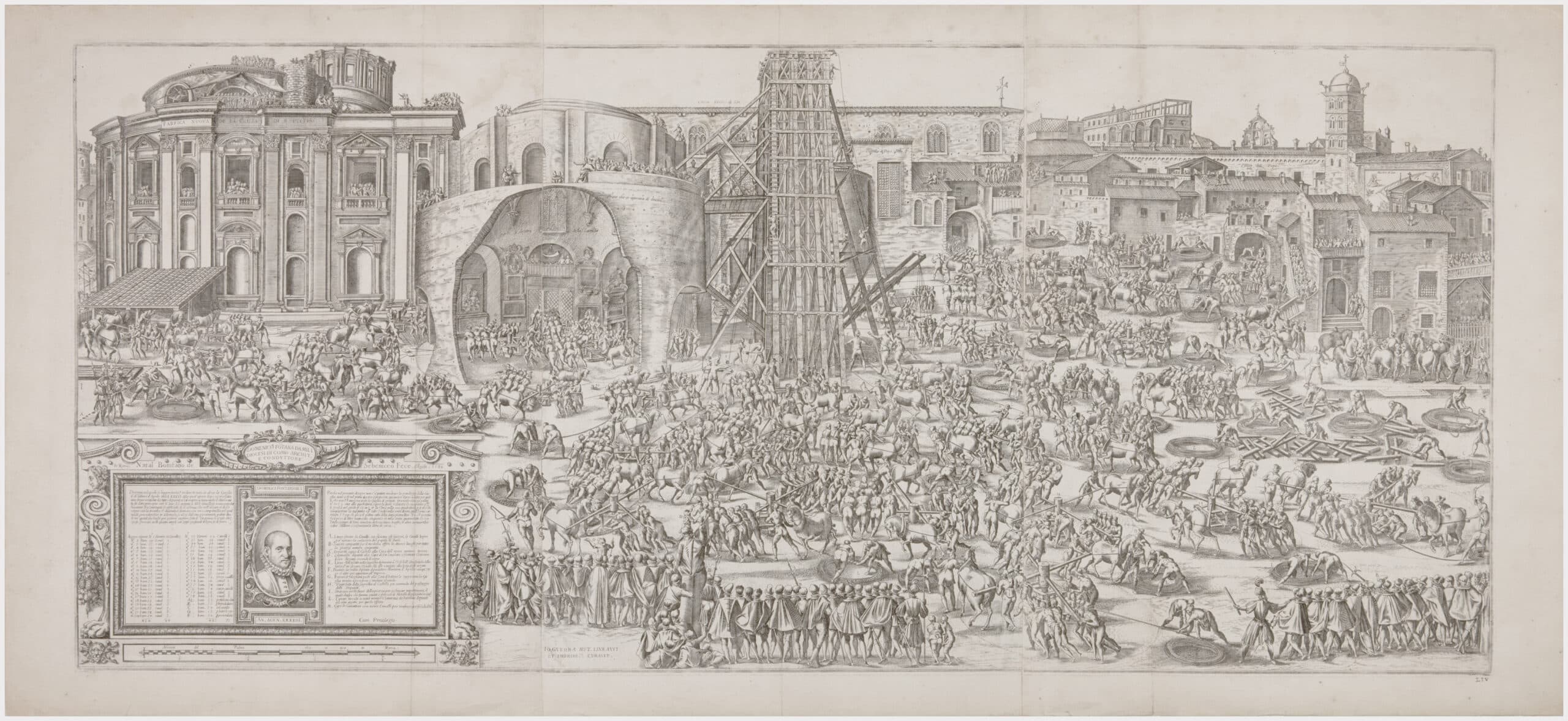
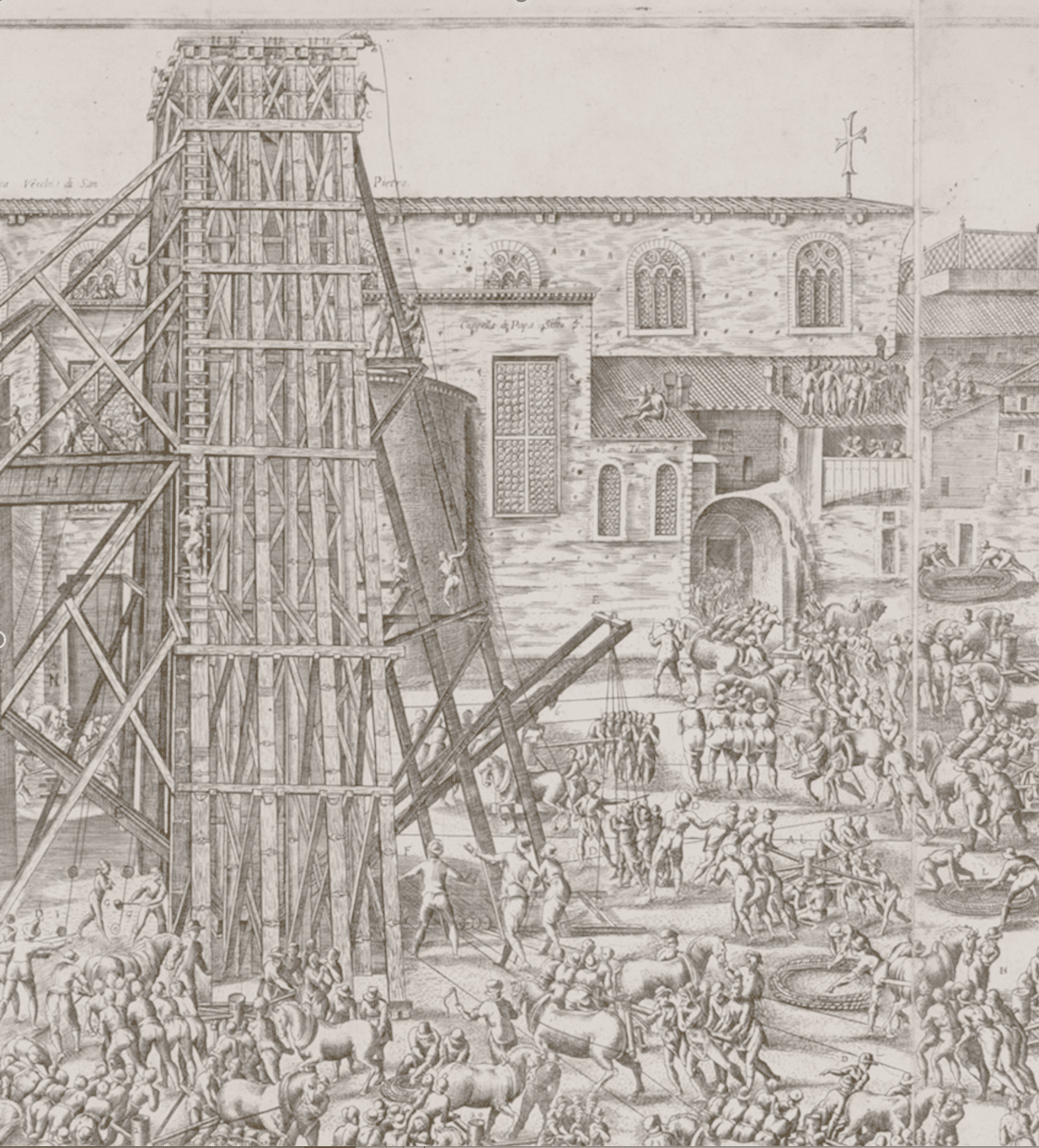
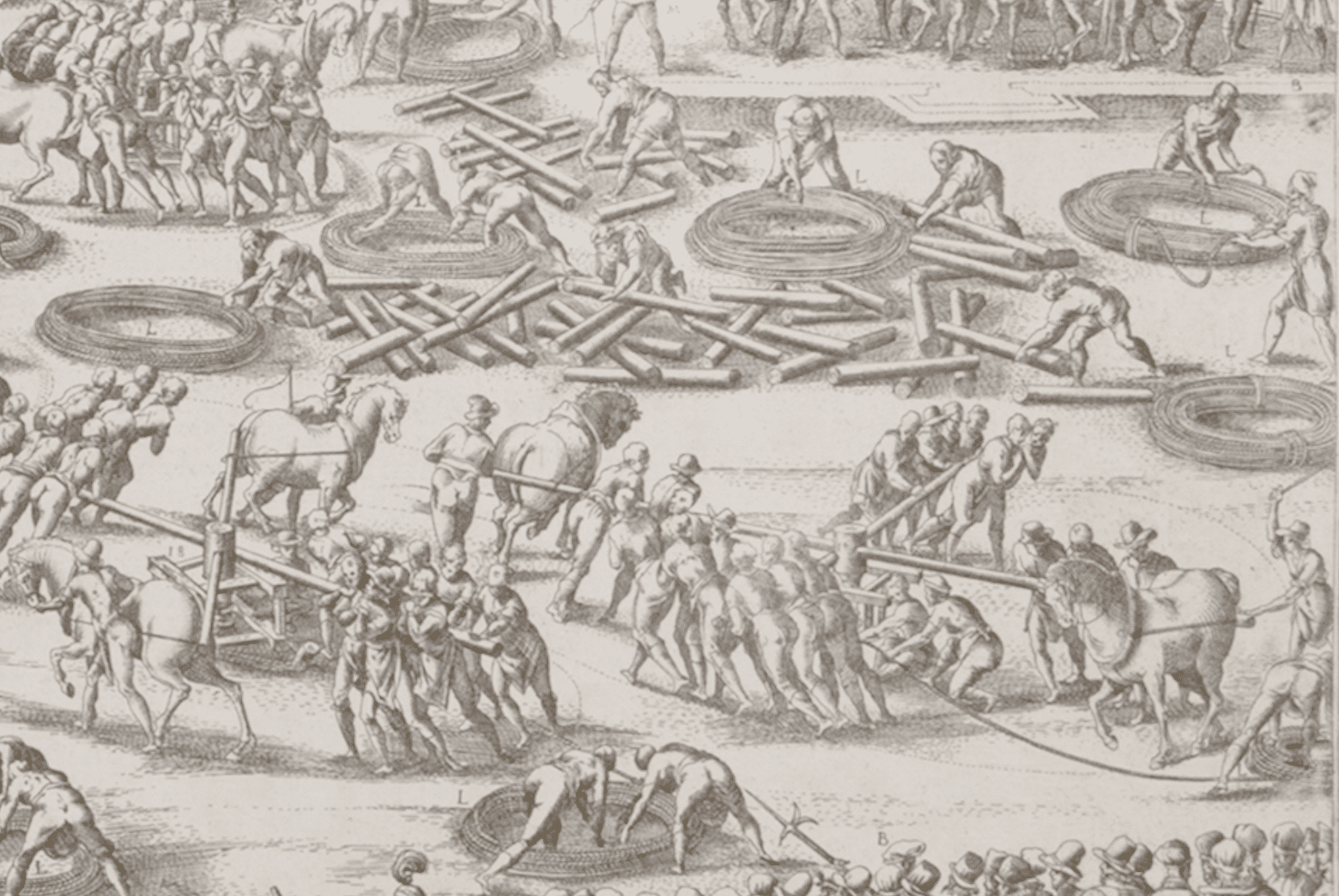
Despite the frenzied activity, it is a still image that records a precise moment, unlike the first image that narrates the full process. The second image captures the coordinated action of the workers pulling the ropes simultaneously — a key element since an unbalanced distribution of the weight of the massive stone could jeopardize its stability and cause a major disaster. [9] The mainly silent operation was punctuated by trumpet blasts addressed to the controllers of forty numbered capstans signaling them to move and by a bell on top of the castello that rang to tell everyone to stop. These and many other coordinated moves, whose complexity is suggested by the still image, are described in the text of Fontana’s book, but flipping through the book’s pages is closer to the overall movement synthesized in the March engraving. As Ingrid D. Rowland suggests, because the book was aimed at an international audience, Fontana could have written it in Latin but chose Italian, the language of the worksite, which allows a directness and fluency in explaining his choices and recounting certain dramatic moments. [10] This fluency has its counterpart in the image selection, which is coordinated with the text to allow a complementary rhythmic reading.
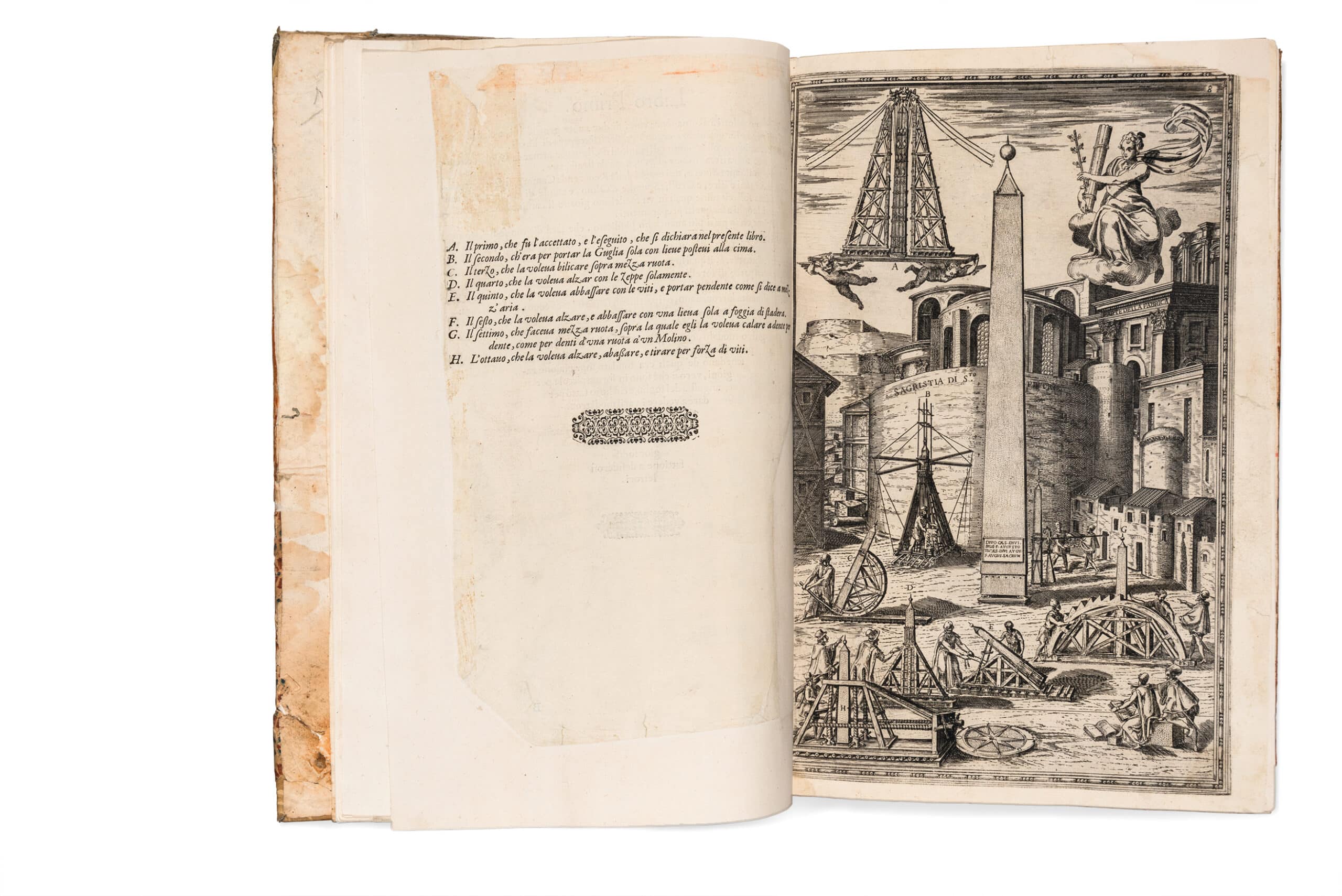
In considering rhythm, we want to focus on the way Fontana masters the thirty-six-page sequence representing the moving of the obelisk from start to finish. It begins with a frontispiece that, echoing Vignola, is centered on a portrait of Fontana, who holds an obelisk. After the dedication to Sixtus V, Fontana describes the tricky process of obtaining the job and the various proposals presented to the project commission on 18 September 1585. [11] The first image, on page eight, is a perspective featuring seven of these proposals placed on the ground around the obelisk in its original location, and, above them in the sky, Fontana’s proposed castello is supported by two angels. This plate is followed by five pages of text that outline how the stone’s weight and the required strength of the castello were calculated. This section culminates with a spread featuring the castello on the right-hand page (12 recto) and the corresponding captions on the left (11 verso). The scene depicts the work done on 30 April 1586, the first stage of the operation. Then, four further text pages precede a general plan that resumes the activity on the day the obelisk was raised, showing the forty capstans in their relative positions. This engraving also includes the partially demolished sacristy of Saint Peter’s and all four elevations of the protective sheath in which the obelisk was encased. The choice of paper and the page-numbering system do not differentiate between text and image; both are printed on the same paper, and the images consistently face the verso of the text pages. Thus, the page sequence closely follows the chronological unfolding of the move, while also providing captions and headlines in just the right spots for the benefit of less patient readers. [12]
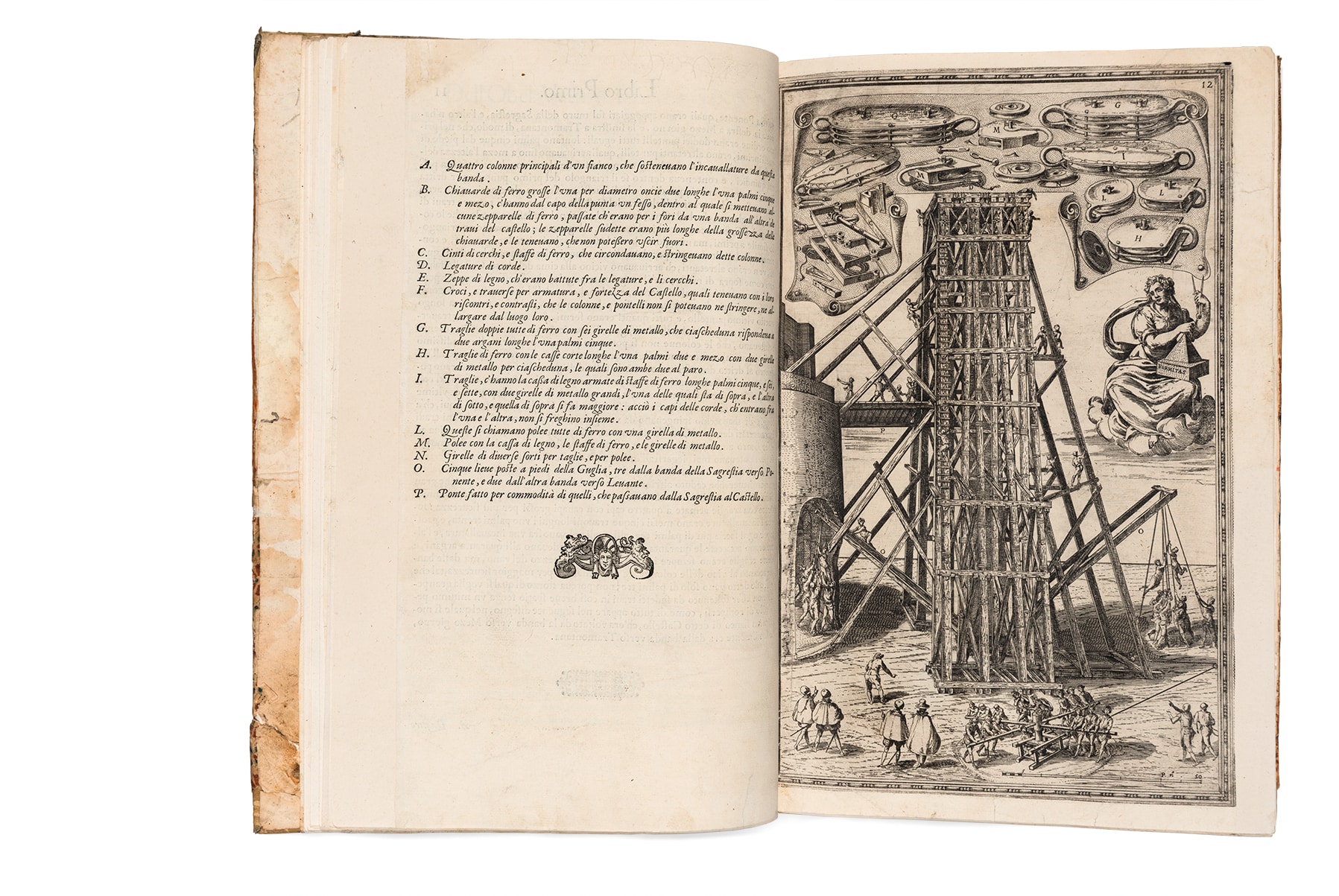
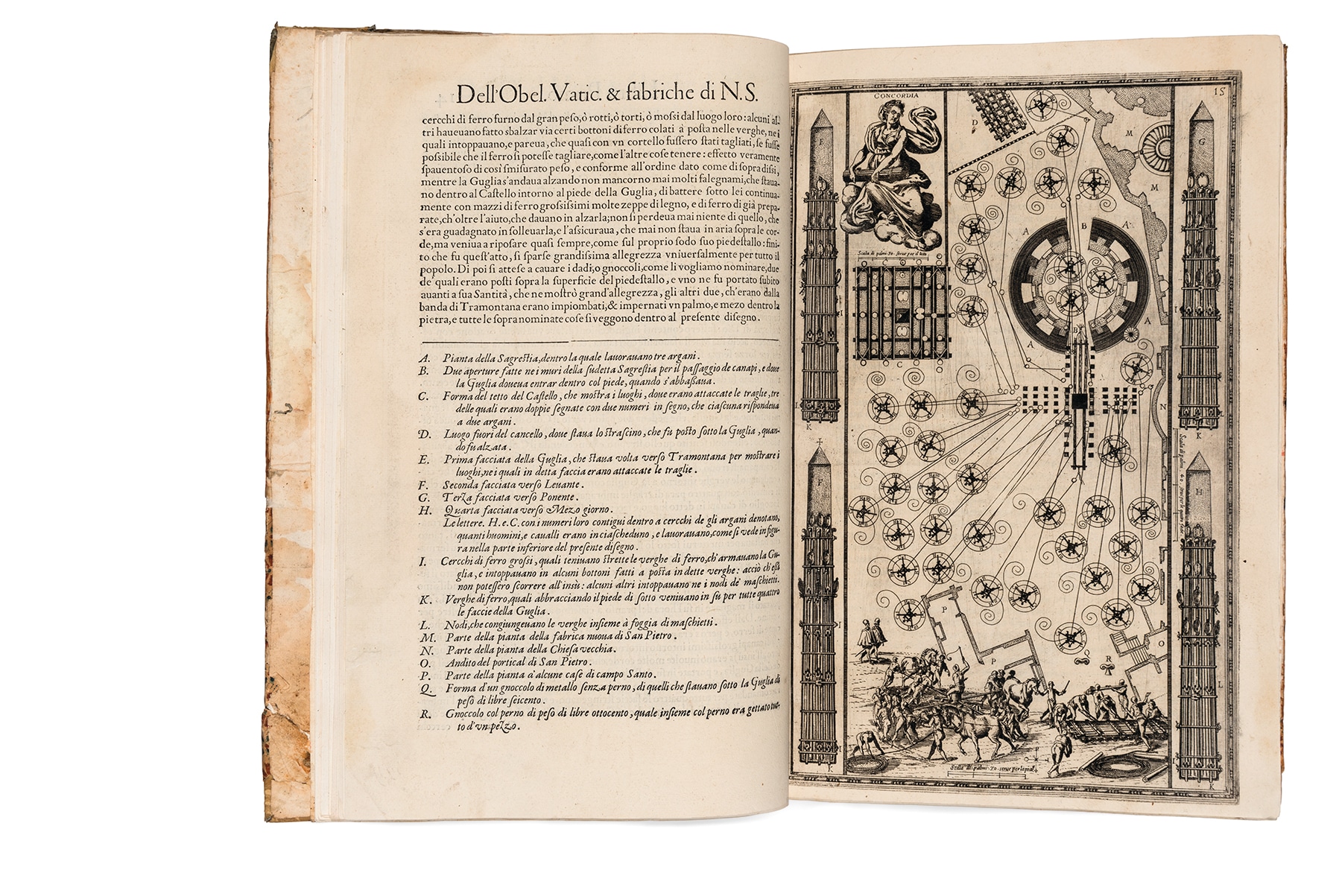
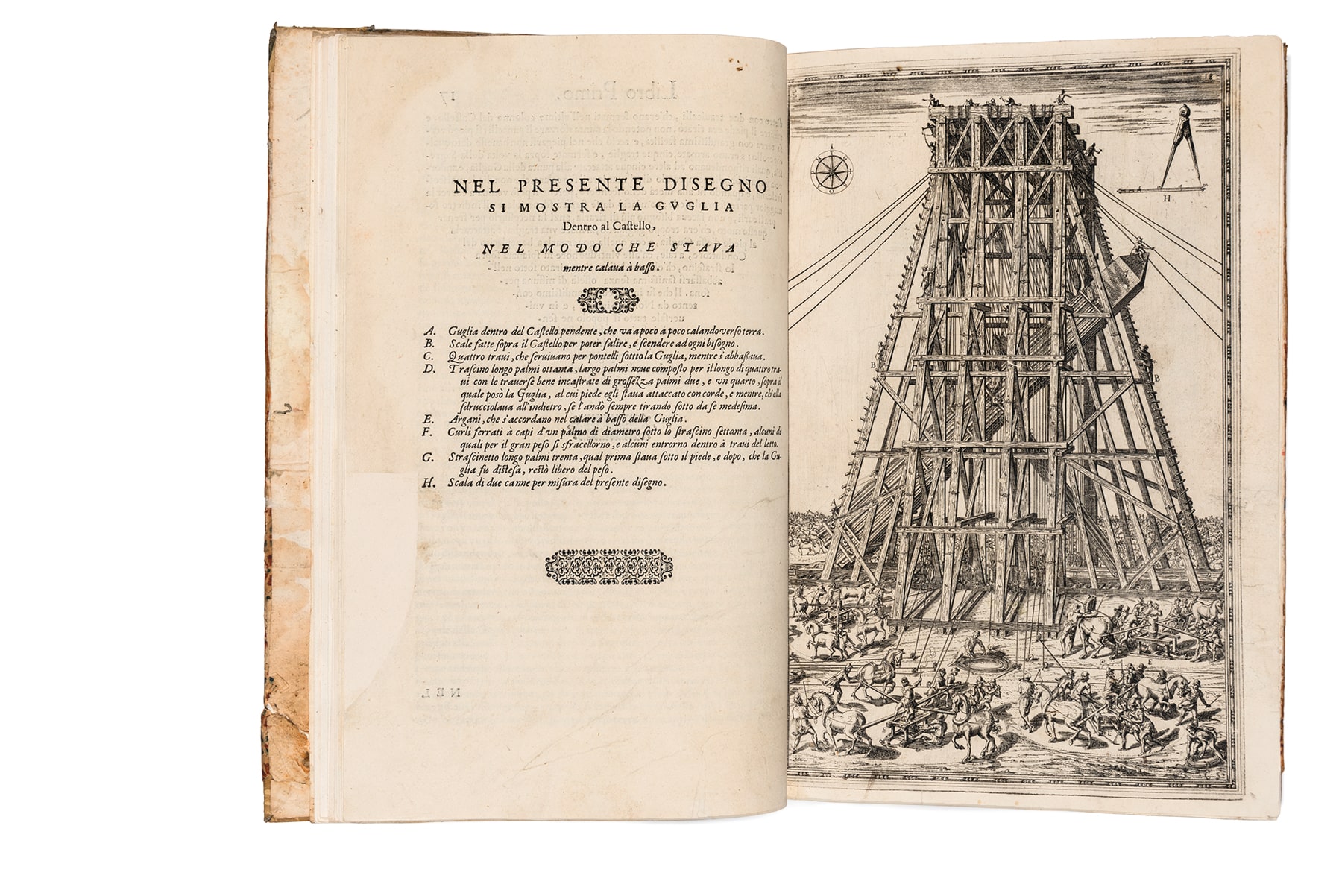
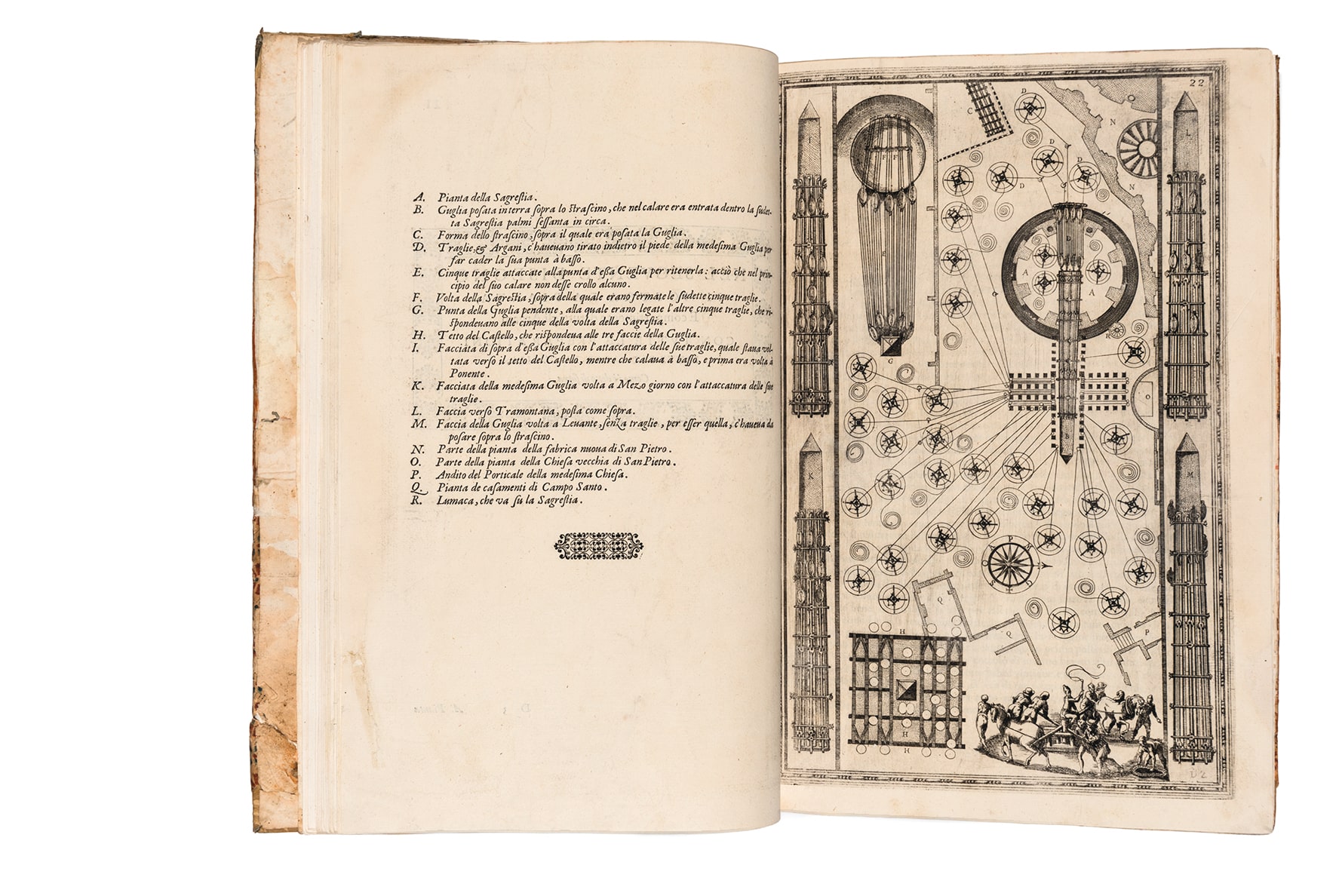
Even though ancient knowledge for moving obelisks had been lost, another pair of text pages proclaim the superiority of Fontana’s technique over ancient methods. A telegraphic message on page nineteen introduces a perspective on page twenty, where we see the obelisk finally lying on the sledge. This is then followed by a right-hand-page telegraphic explanation again anticipating a right-hand full-page plan; there, on page twenty-two, the obelisk is still lying on the sledge, but many capstans have been moved, signaling that another stage of the process is ready to start. Another text page introduces a majestic side elevation where the obelisk moves, as in a procession, toward its final destination; then the castello is re-erected in the final position, the obelisk dragged underneath it — a cross-section shows everything prepared to raise the needle, we see the plan with the new distribution of the capstans around the castello, and finally a text section details the raising and fixing of the stone in its new position. From page eighteen to thirty-two, all right-hand pages feature an engraving, and all left-hand pages contain text, whether a short description or a more detailed explanation. Step by step, page by page, interweaving text and image, the operation unfolds rhythmically before the eyes of the reader. The final exposition on pages thirty-three and thirty-four precede the accomplished representation of the obelisk set dutifully in place in front of a completed Saint Peter’s church; a transcript of the new inscription on the obelisk and a dedication to Pope Sixtus V conclude the epic.

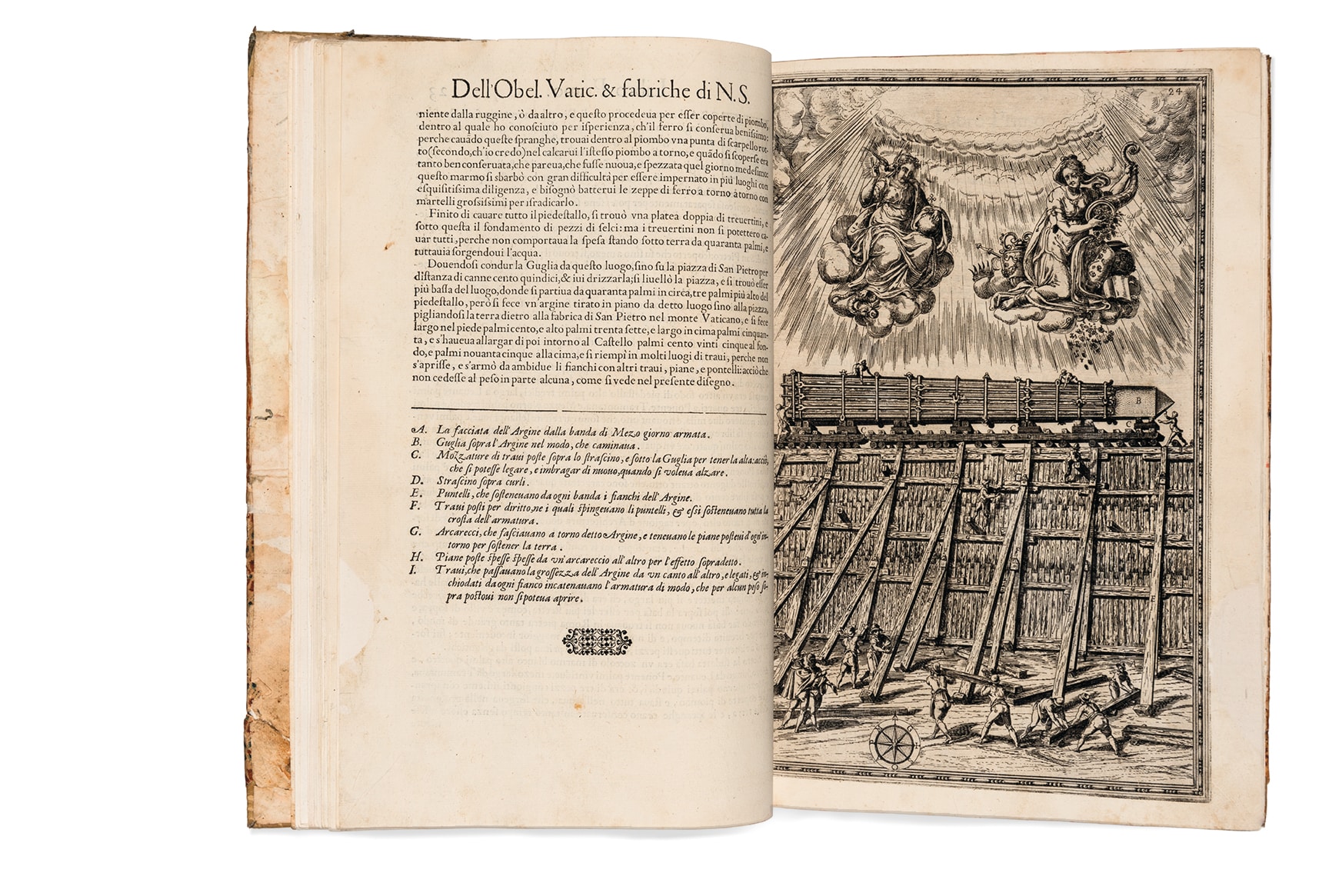
Fontana’s account opens with an explanation of how he convinced the commission appointed to select the best scheme for the transportation of the obelisk and to choose his solution. He describes a public performance:
I brought my wooden model, within which was a needle of lead in proportion to the cables, blocks, and smaller members of the same model, which were to lift it. In the presence of all the signori of the commission and of the aforesaid masters of the arts, I raised this needle and lowered it by degrees, demonstrating with words and step-by-step the reason and foundation of each movement, in order and then in action. [13]
The miniature wooden castello and lead obelisk worked like magic in the pious hands of the architect. Animating the proposal for the selection committee, an audience without technical knowledge synthesised the architectural concept and brought it to life. [14] The book pages also aim at such an effective demonstration, this time with the added authority of a successfully accomplished task. Hence, from September 1585 (when the proposals were presented) to September 1586 (when the obelisk was fixed in its final position) the book allows us to follow the design and execution of the project. The page sequence weaves descriptions, headlines, timelines, and visual accounts together to engage the reader in a full architectural experience. There is an astounding coincidence between the architect’s public performance and his arguments in front of the committee, the description of the actual move, and the means found to represent it in print. Such coincidences between preconceived strategy, successful mise-en-œuvre, and the setting of the book conspire to produce an ideal portrait. Indeed, other accounts of events slightly contradict and moderate Fontana’s epic description. His story ends sadly: Fontana lost the privileges he enjoyed as ‘Our Lord’s Architect’ upon the Pope’s death and left Rome to seek protection and work in Naples. Nevertheless, the sequence of his book pages brings back his most glorious moment, the ‘sound of drums and trumpets’ that accompanied him home on the day he managed to move the obelisk.
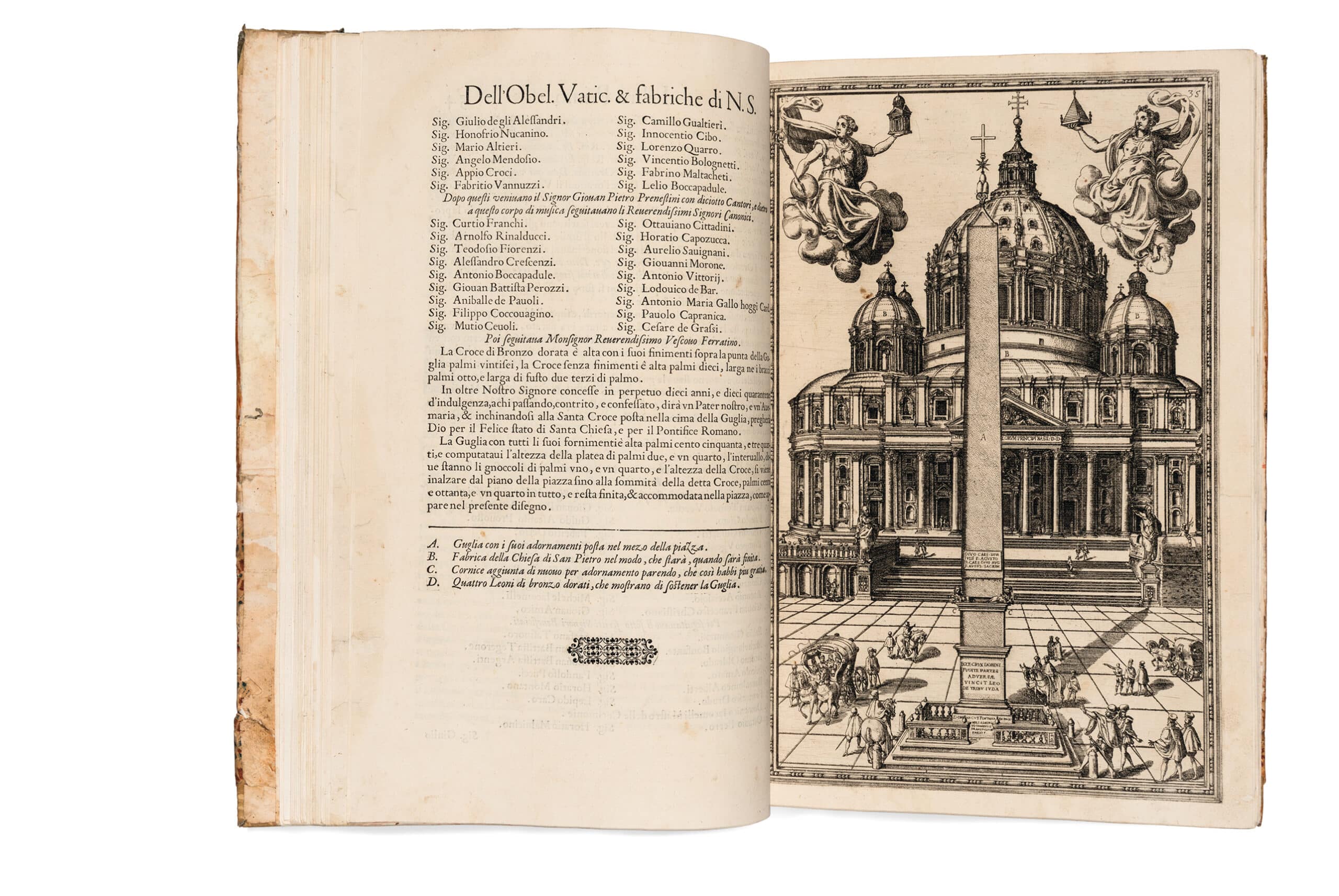
Extracted, with permission, from The Anatomy of the Architectural Book by André Tavares, published by Lars Müller Publishers © 2015.
Notes
- Paolo Portoghesi, ‘Domenico Fontana architetto e urbanista’, in Domenico Fontana: Della trasportatione dell’obelisco vaticano 1590, ed. Adriano Carugo (Milan: Polifilo, 1978), xi–xviii.
- Brian A. Curran, Anthony Grafton, Pamela O. Long, and Benjamin Weiss, Obelisk: A History (Cambridge, MA: Burndy Library, 2009). On the Vatican obelisk, see in particular the chapters ‘Moving the Vatican Obelisk’ and ‘Changing the Stone: Egyptology, Antiquarianism, and Magic’, pp.103–58. See also Bern Dibner, Moving the Obelisks (1950; repr., Cambridge, MA: The MIT Press, 1970).
- Ibid., p.44.
- Domenico Fontana, Della trasportatione dell’obelisco vaticano et delle fabriche di nostro signore Papa Sisto V (Rome: Appresso Domenico Basa, 1590). A facsimile edition with English translation by David Sullivan was published in digital version as Della trasportatione dell’obelisco vaticano (Oakland, CA: Octavo, 2002).
- Ibid. (1590), 14r.; (2002), p.25.
- Ibid. (1590), 3v.; (2002), p.6.
- Also in March 1586, Filippo Pigafetta (1533–1604) published a booklet entitled Discorso di M. Filippo Pigafetta d’intorno all’historia della aguglia, et alla ragione del muouerla (Rome: Bartolomeo Grassi, 1586). Unlike the architect’s book, this small treatise presented a history of obelisks and outlined a method for determining an obelisk’s weight.
- Plan, Elevation, and Perspective of the Castello Used in the Transportation of the Vatican Obelisk; and Views of the Original and Final Location of the Obelisk, engraving on laid paper, 52.3 × 119.1 cm, March 1586, CCA DR 1987:0026. Eve Blau and Edward Kaufmann, eds., Architecture and Its Image: Four Centuries of Architectural Representation. Works from the Collection of the Canadian Centre for Architecture (Montreal: Canadian Centre for Architecture, 1989), p.270.
- Fontana, Della trasportatione dell’obelisco vaticano (1590), 13v.; (2002), p.24.
- Ingrid D. Rowland, ‘Della trasportatione dell’obelisco vaticano’, in Fontana, (2002), p.1–10.
- Even after Fontana, aged forty-two, secured the commission as ‘Our Lord’s Architect’, he still had to overcome the opposition of older architects like Giacomo Della Porta (1532–1602) and Bartolommeo Ammanati (1511–1592), who had been appointed by a commission to direct the works.
- See ‘A book in a hurry’, in André Tavares, The Anatomy of the Architectural Book (Zurich: Lars Müller Publishers/Canadian Centre for Architecture, 2016), pp. 73–8.
- Fontana, Della trasportatione dell’obelisco vaticano (1590), 5r.; (2002), 10.
- Rowland notes, as Cesare D’Onofrio originally pointed out in his Gli obelischi di Roma (1967), that ‘the decision was made by a commission of four cardinals, a bishop, and officials of the Roman city council’, whom Fontana had to reassure of the feasibility of his procedure. Rowland, ‘Della trasportatione dell’obelisco vaticano’, 5.
